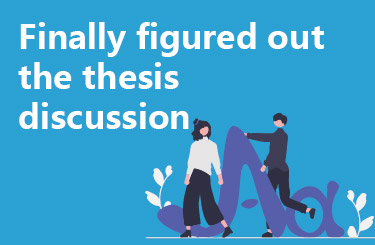I. Discussion plays an important role in highlighting the innovativeness of one’s research and its clear differentiation from others. The size of the difference is also a matter of discussion. Difference is a sign of innovation.
A formal academic paper usually consists of an abstract, introduction, literature review, research design, results and discussion, conclusion, acknowledgements and references.
Step 1: Overview of the current study
Before proceeding to the specific discussion, you first need to do a review of your current study. Because the reader reads the discussion here is likely to have forgotten what you study, so you need to remind the reader. Here a paragraph is enough!
Step 2: discuss the relationship between the results of this study and the existing literature
The DISCUSSION should echo the literature mentioned in the literature review.
Step 3: Discuss unexpected, or surprising findings
Step 4: Clarify how the results of this study relate to relevant theoretical models
After talking about the relationship with the previous specific STUDY, it’s time to start discussing the theoretical part! This is the place to take the long view and think of the whole BIGGER picture!
Step 5: Discuss the shortcomings of the study (limitation)
Any study will have limitations, no study can be perfect! So just acknowledge these limitations, and here is where your critical thinking comes into play.
Step 1: Summarise the current study (overview)
In the specific discussion before, first need to do a review of your current study.
Because the reader reads the discussion here is likely to have forgotten what you study, so you need to remind the reader. Here a paragraph is enough!
You can.
● Re-phrase your research question.
●Review your research methodology
Highlight the key findings – note that they are the core findings, not all the results mentioned in the results section.
●Inform the reader of the structure of discussion.
Step 2: Discuss the relationship of the findings to the existing literature.
The discussion should echo the literature mentioned in the literature review.
In this section, answer the following questions.
● Are your findings [consistent] with the existing literature? How? How?
● (More important!) Are your findings [inconsistent] with the existing literature? What is inconsistent?
● Why are they inconsistent? How can you explain their inconsistency?
Come up with three or so points that you think might have caused them to be inconsistent (a lot of critical thinking is needed here)! Try to find references here too!
Also discuss why some of the reasons have been ruled out and why you feel they don’t apply to the current inconsistency. This will make your discussion section seem more critical!
Universal Sentences [Consistent with Current Literature].
●The findings match those observed in earlier studies
● Our findings are in accord with recent studies indicating that…
●There are similrities between the current study and ….
●Incontrast to/Contrary to earlier findings, however, …
●The results provide evidence against the widelyheld assumption in…
●The rstst/indings go exactly counter to the idea that –…
Universal Sentence Patterns
●A possible explanation for this might be that-…
●We speculate that this might be due to…
●Twotypes of accounts could be proposedfor the … The first account assumes that… The second account assumes that…
●The dfference between … and … could be attributable to .
Step 3: Discuss unexpected or surprising findings. In this section, you will answer the following questions.
● Are there any results that are inconsistent with assumptions and unexpected? You can discuss these and give reasons (e.g., are there any results that are not significant).
Other less significant results can be briefly discussed and explained.
● More importantly, what is the value of these unexpected findings? Any new insights that emerged asaresult of your research?
Universal Sentence Patterns [Describing Unexpected Results].
Surprisingly….
●What is surprising is that…
●One unanticipated finding was that…
●Contrary to expectations, this study did not find…
●It is somewhat surprising that …
Universal Sentence Patterns
●The experiment provides a new insight into the relationship between …
● These results should be taken into account when considering how to-…
●The data contributes a clearer understanding of-…
●While previous research has focused onX , these results demonstrate thatY .
●The findingshave extended our knowledgeof…
Step 4:Articulate how the results of this study relate to relevant theoretical models
After talking about the relationship with the specific previous STUDY, it’s time to start discussing the theoretical part! Take the long view and think of the whole BIGGER PICTURE!
● Can any contribution be made to existing theories based on your findings?
● Are your results inconsistent with a theoretical point of view?
● Can you change a theoretical point of view?
● Or can you add something to it?
● Could you propose an updated version of the model based on your research?
This part is also important to get high marks because it is all about the CONTRIBUTION of your research!
Step 5: Discuss the limitations of the study.
Any study will have limitations, there can not be a study is perfect! So just acknowledge the limitations, this is where your critical thinking comes into play.
What are the limitations? (e.g., small sample size, low generlability of results, limitations of experimental equipment)
● Why are there limitations?
● What are the implications of these limitations?
Universal Sentence Patterns [Describe Limitations
●One concern about the findings was that…
●The major limitations of the present study is the…
●The study is limited by…
●Admittedly, the main limitation is…
[Notwithstanding these limitations, they do not affect the validity of the results.
●Notwithstanding these limitations, ….
●Whilst this study did not confirm… ,
●In spite of its limitations,
●In spite of its limitations, …
Other points to keep in mind.
Don’t just repeat the results of RESULTS, focus on the discussion of those results!
Don’t introduce new results!
Be selective in your discussion! Pick the most relevant points to your research question and discuss them!




